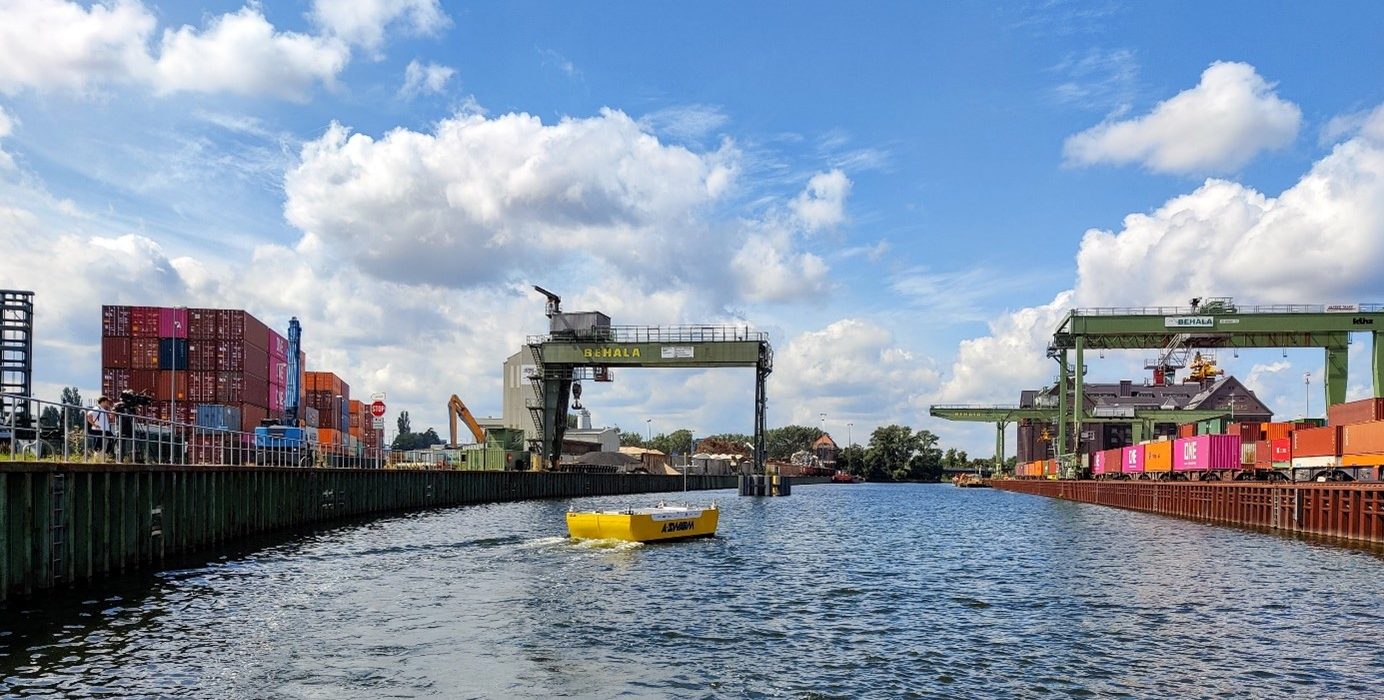The A-Swarm project in Berlin aims to utilise the dense waterway network in and around Berlin for urban logistics in the German capital.
For this reason, the concept of an autonomous ship is being developed as part of our project. This concept includes smaller ship units, which can be linked to form larger convoys. Within the city these convoys split up to deliver individual, decentralised hubs. To provide flexible and emission-free transport, the barges use an electric propulsion system which can rotate to enable route adjustments. The research project aims to find technological solutions for urban waterways logistics.
Many partners are involved in this project. In addition to the operators of the Berlin harbours (BEHALA), the Technical University of Berlin, the University of Rostock, DHL and others are also involved. A-Swarm has already achieved some results in its first research phase. A second research phase is planned. For DHL, the concept shows potential for the waterborne transport of parcels.
Some interesting key facts:
| Name of service | A-Swarm |
| Operator (Research and Development Consortium) | BEHALA, SVA GmbH, TU-Berlin, University of Rostock, DHL Technologies AG Munich, Veinland GmbH Neuseddin and PTJ |
| Market Segment | Parcels |
| Region | East-West (Berlin) |
| Launch year | 2019 |
| Automation | At the moment partial automation with remote control (3), in the future: fully automated operation (5). |
| Barge Capacity | 4-8 Cargo Bike Containers |
| Fleet Size | 2 |
| Ship Length | Now 6m, in future: 14m (Width 6m) |
| Propulsion | Electric drive units in the bow and stern of the ship |
| Equipment | 2x Rotatable RIM Drives 5 Kw, Qualisys Motion Capture System magnets on the sides of the ship, sensor units |
Some more insights about the service
A-swarm offers several advantages, seamlessly integrating an electric, eco-friendly drive with autonomous control and versatile deployment options, including the innovative use of a convoy concept. Notably, its unique strength lies in the ability to divide and link individual vessels as one convoy using strong magnets. Two magnets are attached to each side of the ship, which can be flexibly switched on and off. Each magnet has a holding capacity of three tonnes, allowing the convoy to navigate urban areas in a cohesive formation and enabling decentralised deliveries as soon the convoy enters the delivery area. This ingenious concept significantly enhances the scalability of urban IWT, paving the way for potential future business cases.
It is not yet clear yet whether the magnets will be sufficient to hold an entire convoy together. Presumably, magnets will be used for positioning and another mechanical holding system will close the convoy. The magnets can also help with positioning when mooring the ship. The concept will be expanded in the second research phase.
The DigitalSOW project also aims to expand the concept of supra-regional inland waterway transport so that the bow and stern sections developed there can be used as propulsion units for barges. This would increase the scalability and flexibility of a market-ready concept. Problems when navigating can be caused by signal interference. Satellite-dependent signals such as AIS and GPS can be disrupted under bridges, in locks or between tall buildings, for example. Camera systems can be disrupted in darkness or fog. For this reason, the system has technical redundancies such as infrared cameras to minimise this risk. Accurate positioning is only necessary when locking the convoy and docking the ships. Additionally, the vessel also supports sustainable operations due to electric propulsion.
Lessons learned and roll-out-potential
The A-Swarm project is a promising case, as various insights can be gained from the project work to date. The project offers impressive technical experience in the development of an autonomous boat. This technical development is faster than the regulation of waterway authorities. Within the European framework, adjustments still need to be made to waterway legislation for autonomous transport to enable the development from research project to business case.
A pioneer in this respect is the Flemish region, whose waterways have been declared a test area by the Flemish waterway authorities. This opens many development opportunities in research projects such as AVATAR, in which stakeholders such as Seafar (which provides ship management and services for the operation of unmanned and crew-reduced vessels.) are involved. It is of great importance to continue researching autonomous inland navigation, as there are various open questions not only regarding technical feasibility, which is progressing well, but also regarding economic sustainability.
Certainly, autonomous shipping will reduce operating costs. But what infrastructural adjustments need to be made to enable small-scale autonomous freight transport on urban waterways? Where solutions for autonomous navigation of ships already exist, further insights into the autonomous loading of goods and autonomous docking are needed to estimate the setup costs of the new technology. The A-Swarm project can provide important insights here in the future.
